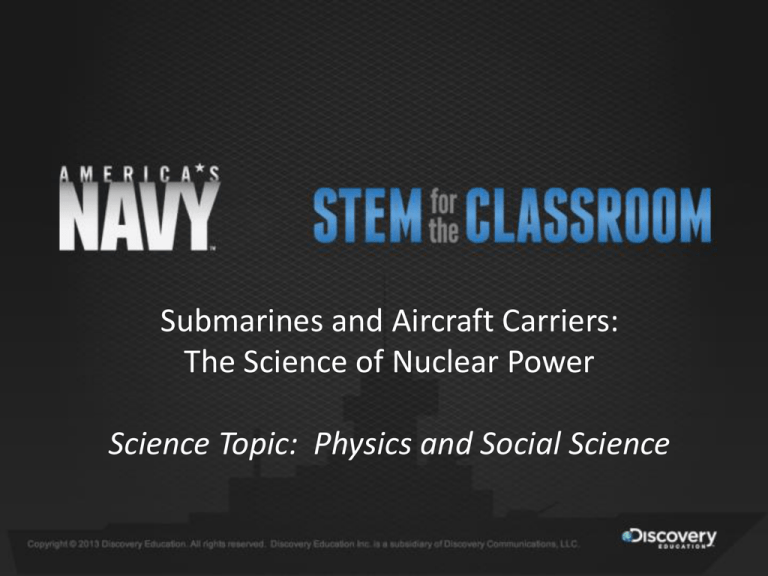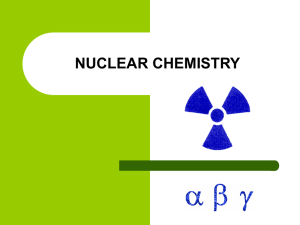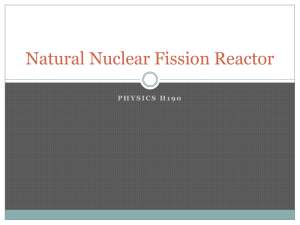
Submarines and Aircraft Carriers:
The Science of Nuclear Power
Science Topic: Physics and Social Science
Matter and Energy: Energy From the Atom
Plot your course to the Arctic Sea!
Use Google Earth or Google Maps to determine the distance in miles from Kitsap Naval
Base in Washington state to a secret location in the Arctic Sea.
How long underwater?
• Example calculation:
– Assume a cruising speed of 20 knots (23 mph)
– If you measured 3,750 miles, the time underwater =
3,750/23 = 163 hours
• Most non-nuclear submarines cannot remain
submerged that long!
• With nuclear power, a submarine is limited only
by its food supply.
Nuclear power is…
• A method of generating electricity
• A means of powering large vessels, such as
submarines and aircraft carriers
• Based on a process involving atomic nuclei:
nuclear fission
Matter and Energy: Energy From the Atom
Fission
A loose neutron…
…collides with
a uranium atom…
…destabilizing it.
Fission splits the atom into two new
elements, releasing energy, gamma
rays and additional neutrons.
Chain reaction
1. A neutron collides with
a uranium atom.
2. The collision releases
energy, and three
additional neutrons.
3. Each neutron in turn
collides with additional
uranium atoms.
Nuclear Fission and Power Plants
Generating Electricity
Containment structure
Pressurizer Steam
Generator
Control
Rods
Electric
Generator
Turbine
Reactor
Vessel
Condenser
See the reactor
in action!
Labels:
• Condenser
• Containment structure
• Control Rods
• Electric Generator
• Pressurizer
• Reactor Vessel
• Steam Generator
• Turbine
Nuclear reactor safety – explosion?
• Could a nuclear
explosion occur?
- critical mass
The minimum amount of
material needed to sustain
an uncontrolled chain
reaction, and therefore cause
a nuclear explosion.
- purity of U-235
Nuclear fuel in a reactor is
about 5% U-235. For a
weapon, U-235 needs to be
about 90% pure.
- an explosion
cannot occur
The purity of U-235 in
nuclear fuel is too low to
sustain an uncontrolled chain
reaction
Nuclear reactor safety – waste
• Why is radioactivity
dangerous?
- regular operations
As uranium fuel is used, it and
its byproducts are highly
radioactive.
- meltdown
- cell damage
Overheating of reactor core
due to loss of cooling ability
or control rod function.
Radioactivity causes damages
cell components and causes
mutations.
To deal with radioactive waste:
• Protect workers
• Store waste safely
Exponential decay
Negative power
relationship
Slower
decay
Faster
decay
Results of half-life activity
• What shape are the observed curves?
• Which of the lines, the class average or the group
line, is closest to the theoretical line? Why?
• What is the difference in the average time for U232 and P-238 groups to use up all their candies?
• What does this difference represent?
Radioactive decay
…radioactivity
is halved…
…then again, and…
…again, and…
Over each half-life…
Half-life of top 10 fission products
Element Name (symbol)
Yield
(%)
Half-life
Caesium (Cs 133)
6.8
2.1 years
Iodine (I 135)
6.3
6.6 hours
Zirconium (Zr 93)
6.3
1,530,000 years
Molybdenum (Mo 99)
6.1
65.9 hours
Caesium (Cs 137)
6.1
30.17 years
Technetium (Tc 99)
6.1
211,000 years
Strontium (Sr 90)
5.8
28.9 years
Iodine (I 131)
2.8
8.0 days
Promethium (Pm 147)
2.3
2.6 years
Percent yield is the
relative amount of each
element resulting from
fission of U-235.
CONCLUSION
• Most fission products have
relatively short half-lives (<
90 years).
BONUS FACT
• Seven fission products have
very long half-lives. (Only two
of those are shown.)
Types of radioactive decay
Type of Decay
(symbol)
Cause
Particle Emitted
Example
Alpha (α)
Excess neutrons cause Helium nucleus
repulsion
Uranium-238 to
Thorium-234
Beta (β)
Excess neutrons cause Electron
conversion
Hydrogen-3 to
Helium-3
Gamma (γ)
Nucleus energy too
high
Cobalt-60 to
Nickel-60
Photon
Penetrating power of decay particles
Predicting decay products
• How does alpha decay
affect an isotope?
• What is the atomic
number and atomic weight
of helium?
• What is the new atomic
mass and atomic number?
Loss of a helium
nucleus
Atomic number = 2
Atomic weight = 2
Subtract 2 protons
Subtract 2 neutrons
Loss of protons changes the element.
Transmutation = change from one element into another
Predict alpha decay – example
• Problem: an atom
of 238U emits an
alpha particle,
undergoing alpha
decay. What is the
product of this
process?
Solution:
1. Write the equation:
2. Subtract values for helium from uranium:
Atomic mass = 238 – 4 = 234
Atomic number = 92 – 2 = 90
3. Look up the periodic table.
(In the periodic table, the element with
atomic number 90 is thorium.)
Answer: The decay product is thorium-234 (234Th)
Radioactive decay chain
Uranium Thorium Radium Radon Polonium Lead
U
Th
Ra
Rn
Po
Pb
– 1 α particle
Check the periodic table to find the atomic numbers for each of
the elements. Do you see a pattern?
How long is radioactive waste
dangerous?
• It depends on the half-life of the products of
fission and decay
• A few decades to millions of years
• It can be made safer if stored properly
Matter and Energy: Energy From the Atom
The Science of Nuclear Power
• Example concepts
nucleus
nuclear reactor
chain reaction
radioactivity
alpha particle
nuclear fission
critical mass
gamma rays
exponential decay
half-life
transmutation
nuclear decay
Copyright© 2013 Discovery Education. All rights reserved. Discovery Education, Inc. is a subsidiary of Discovery Communications, LLC.
Energy yield of nuclear fuel
• Fun factoids!
Type of
Engine
Engine
Efficiency
Energy
Yield (1g)
Diesel
40 – 50%
5 x 104 J
Nuclear
30 – 40%
9 × 1010 J
– 1 gram of nuclear fuel provides 1.76 million times
the energy from a gram of gasoline
– If your car was nuclear-powered it could travel 5
billion miles to the gallon
At Sea: Submarine Warfare
Essential (Guiding) Questions
• How does a nuclear reactor work?
• What are the benefits and risks of nuclear
power?
• What are basic terms used in the fields of nuclear
power and nuclear physics?
• How are quantitative data related to radioactivity
analyzed?
• Can you define the key words?
Key Vocabulary
•
•
•
•
•
•
alpha particle
chain reaction
critical mass
exponential decay
gamma rays
half-life
•
•
•
•
•
•
nuclear decay
nuclear fission
nuclear reactor
nucleus
radioactivity
transmutation






![The Politics of Protest [week 3]](http://s2.studylib.net/store/data/005229111_1-9491ac8e8d24cc184a2c9020ba192c97-300x300.png)




